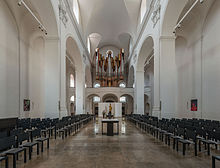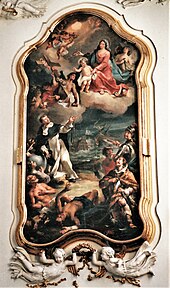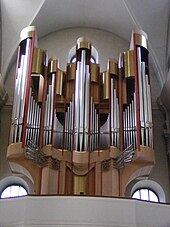Augustinian Church (Würzburg)
The Augustinerkirche is a Catholic church building in Würzburg . The monastery church of the Augustinian order is located in the city center , between Dominikanergasse and Dominikanerplatz. Before 1813 it was a Dominican church , which was rebuilt from 1741 to 1744 on top of a previous church. Until 1824 the older Augustinian church of the Augustinian monastery was in Augustinerstraße.
history
The construction of the church began in 1266 on behalf of the Dominicans , who had lived in Würzburg since 1227. In 1274 the church was consecrated to St. Paul. The Gothic construction was completed in 1308. The monastery complex was redesigned in baroque style by Antonio Petrini between 1688 and 1691.
Until the last third of the 15th century there was a beguinage subordinate to the Dominican monastery in the nearby house of the little lion .
In 1741 Balthasar Neumann was commissioned to redesign the Dominican Church in the baroque style. In 1743 he had the Gothic main nave completely demolished and built a new baroque building on its basis by 1744, connecting the nave, designed as a pillar basilica with wide and high arcades, with the Baroque choir / apse area.
In 1813 the Augustinians (hermits), who had lived in Würzburg since 1263, had to vacate their monastery (on the site of today's police headquarters in Augustinerstraße) and move into the vacant Dominican monastery from the Grand Duke through their prior Antonius Lauck. The new Augustinian Church was opened in 1813. The former monastery church was demolished in 1824.
Due to the bombing of Würzburg on March 16, 1945 , the church lost almost all of its interior fittings.
Since then the church has been renovated and redesigned several times, with the baroque orientation of the church being retained. Only the most recent redesign (September 2010 to November 2011), which is always controversial, deviated from this by implementing the communion model as a spatial concept. The theological idea behind the transformation is the understanding of the church as a “community of successors of equals”, which is formulated in Gal 3:28: “There is no difference between Jews and Greeks, free and slaves, man and woman.” This idea finds Their implementation, among other things, in the following points:
- The walls are whitewashed.
- Church pews were dispensed with in favor of flexible individual seating. The chairs are usually placed in an oval around the altar.
- In the Augustinian Church, not a single seat is reserved for someone because of the role that he / she performs in the service. Accordingly, there is no priestly seat.
- The figure of the Virgin, made by Jakob van der Auvera around 1720, depicts Maria, as was customary back then for around 200 years, as queen with a crown and standing barefoot on the ground at the same time. Here two incompatible statuses are combined in one figure and thus dissolved.
- The Augustinus figure, created in 2011 by Thomas Hildenbrand in the church's choir stalls, depicts the father of the order of the Augustinians as a brother and creator of the rule of the order, but without any church decorations (bishop's staff and ring, miter).
- The Way of the Cross by Jacques Gassmann, created in 2011, underlines - like every Way of the Cross - the voluntary renunciation of status (Phil 2: 6-11).
- The high altar painting New Jerusalem by Jacques Gassmann refers to Apk 21f, in which the New Jerusalem is described as a city in which the streets are made of pure gold and the city gates are each made of a pearl. The foundation walls of the city are decorated with precious stones. If one assumes that in antiquity special jewelry served to represent honor and status, it becomes clear: In the new Jerusalem there are no longer any status differences, as the material that was used to create the status markers (gold, precious stones, pearls) , are pure building material.
With this concept, the Augustinian Church in Würzburg asks the division of the people of God into clergy and lay people as well as the self-evident talk of the church as a hierarchical organization.
organ
The Augustinian Church has a three-part organ system with a total of 73 registers, consisting of the main organ on the west gallery, the choir organ in the choir and a tube system.
The main organ and the choir organ were built in 1995/1996 by the organ building company Klais (Bonn): the main organ with 54 stops on three manuals and pedal , the choir organ with 14 stops on two manuals and pedal. The choir organ could be played from the console of the main organ (the two manual works of the choir organ could be registered on the 4th manual of the console of the main organ).
In the course of the restoration of the church, the organ building company Seifert (Kevelaer) under the leadership of the church musician at the time, Christian Bischof, built an English high-pressure works (tube works) in a blind window niche. a. recorded the tuba 8 ′, which was previously part of the solo work. The tube work can be played as an auxiliary work from the main organ. In addition, the disposition of the main and choir organ has been changed slightly. The console of the main organ was equipped with new electronic playing technology. The main organ today has 58 stops on three manuals and pedal. The action actions on the gallery table are mechanical (with the exception of the action of the tube works and the choir organ works), the stop actions and couplings are electric.
|
|
|
|
|||||||||||||||||||||||||||||||||||||||||||||||||||||||||||||||||||||||||||||||||||||||||||||||||||||||||||||||||||||||||||||||||||||||||||||||||||||||||||||||||||||||||||||||||||||||||||||||||||||||||||||||||||
- Couple:
- Normal coupling: II / I, III / I, III / II, IV / I, IV / II, IV / III, I / P, II / P, III / P, IV / P
- Sub-octave coupling: II / II, III / I, III / III
- Super octave coupling: II / II, III / III, III / P
- annotation
- (N) = Register added subsequently
The choir organ was built with 15 registers on two manuals and pedal, and today it has 15 registers on two manuals and pedal. Two stops have been added to the main work, and the former Comhorn 8 'tongue stop has been removed. The manual works of the choir organ can today be separated from each other on the II. And III. Connect the manual of the gallery table and play together from the fourth manual.
|
|
|
|||||||||||||||||||||||||||||||||||||||||||||||||||||||||||||
- annotation
- (N) = subsequently added register
Bells
The ridge turret on the roof houses three bells from 1949:
1st Augustine bell, striking note a ', 450 kg
2. Marienglocke, strike tone c ", 230 kg
3. Paulus bell, striking tone d ", 200 kg
literature
- Stefan Kummer : Architecture and fine arts from the beginnings of the Renaissance to the end of the Baroque. In: Ulrich Wagner (Hrsg.): History of the city of Würzburg. 4 volumes; Volume 2: From the Peasants' War in 1525 to the transition to the Kingdom of Bavaria in 1814. Theiss, Stuttgart 2004, ISBN 3-8062-1477-8 , pp. 576–678 and 942–952, here: pp. 654 f.
Web links
See also
Individual evidence
- ^ Bruno Rottenbach: Würzburg street names. Volume 1, Franconian Society Printing Office, Würzburg 1967, p. 38 ( Dominikanerplatz ).
- ↑ Lucia Longo: Antonio Petrini. A baroque architect in Franconia. (Schnell & Steiner artist library). Schnell & Steiner, Munich / Zurich 1985, ISBN 3-7954-0374-X , p. 32
- ^ Peter Kolb: The hospital and health system. In: Ulrich Wagner (Hrsg.): History of the city of Würzburg. 4 volumes, Volume I-III / 2 (I: From the beginnings to the outbreak of the Peasant War. 2001, ISBN 3-8062-1465-4 ; II: From the Peasant War 1525 to the transition to the Kingdom of Bavaria 1814. 2004, ISBN 3 -8062-1477-8 ; III / 1–2: From the transition to Bavaria to the 21st century. 2007, ISBN 978-3-8062-1478-9 ), Theiss, Stuttgart 2001–2007, Volume 1, 2001, p 386-409 and 647-653, here: pp. 400 and 650.
- ^ Bruno Rottenbach: Würzburg street names. Volume 1, Franconian Society Printing Office, Würzburg 1967, pp. 38 and 96.
- ↑ Peter Reinl in: See, I make everything new . Innovation as a strategic challenge in church and society. Paulinus, Trier 2012 p. 269ff. ISBN 978-3-7902-1822-0 .
- ↑ To the main and choir organ on the website of the builder company
- ^ Vita of Christian Bischof
- ↑ More information about the organs and their disposition ( memento of the original from November 5, 2016 in the Internet Archive ) Info: The archive link was inserted automatically and has not yet been checked. Please check the original and archive link according to the instructions and then remove this notice. of the Augustinerkirche on orgel-information.de, accessed on November 5, 2016
Coordinates: 49 ° 47 '45.9 " N , 9 ° 55' 53.6" E





